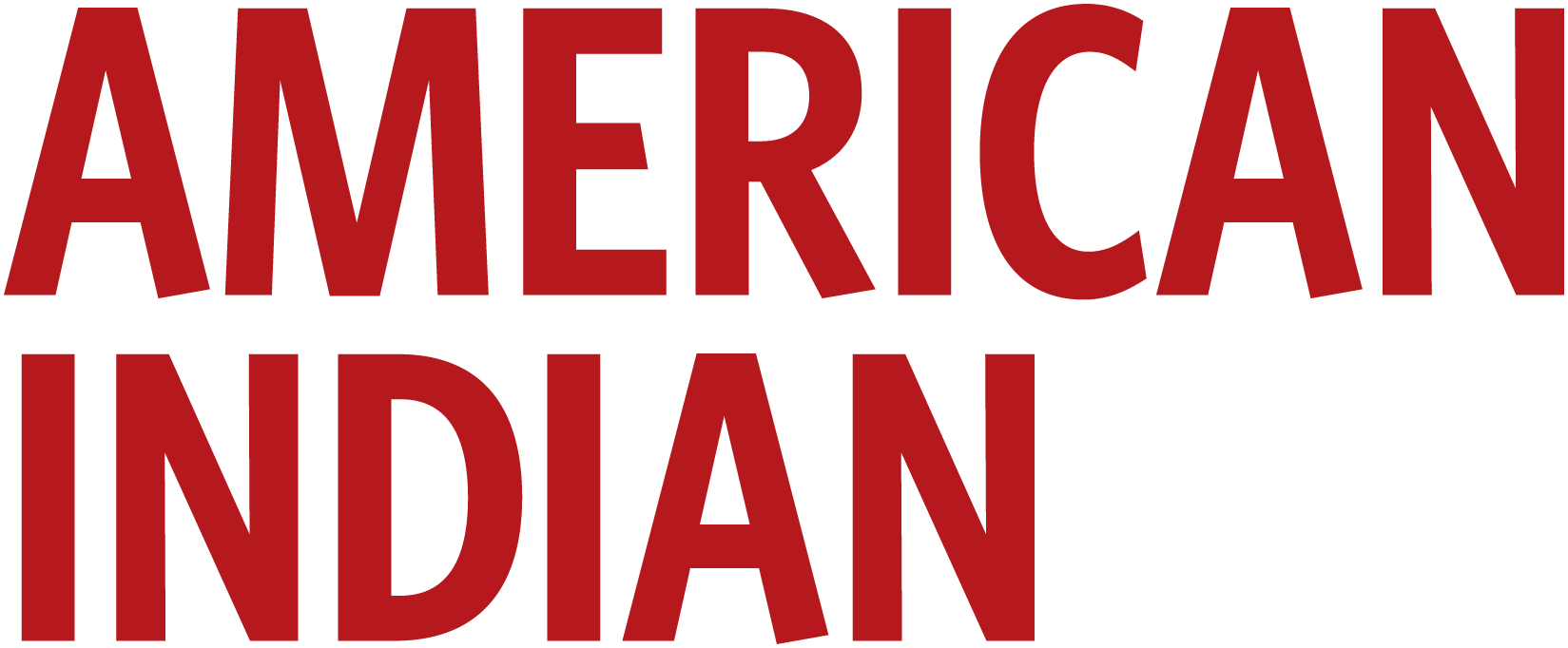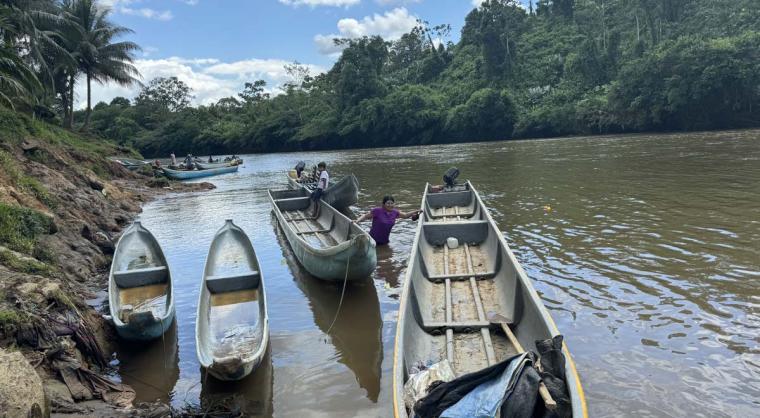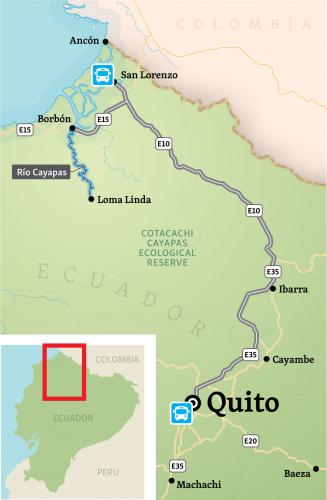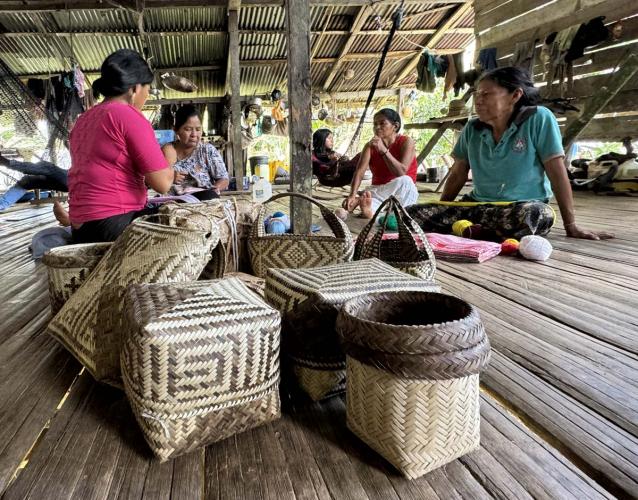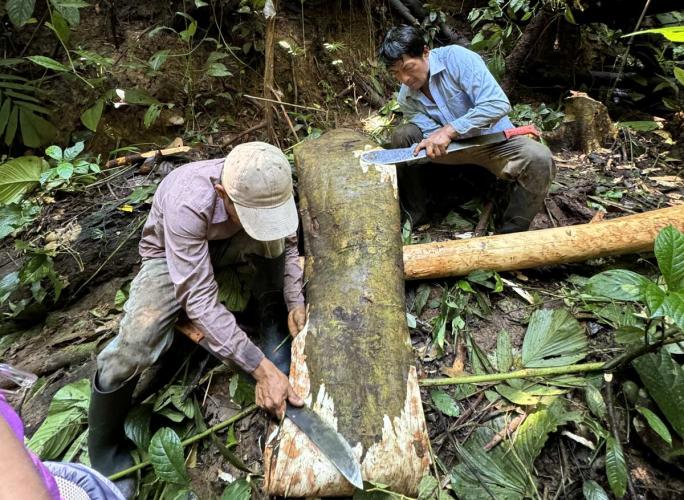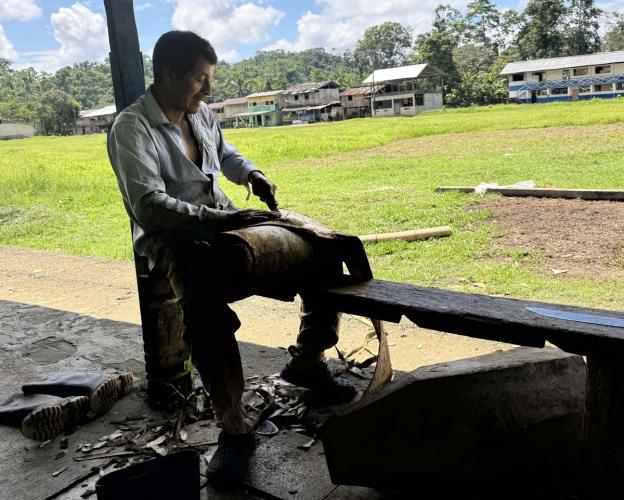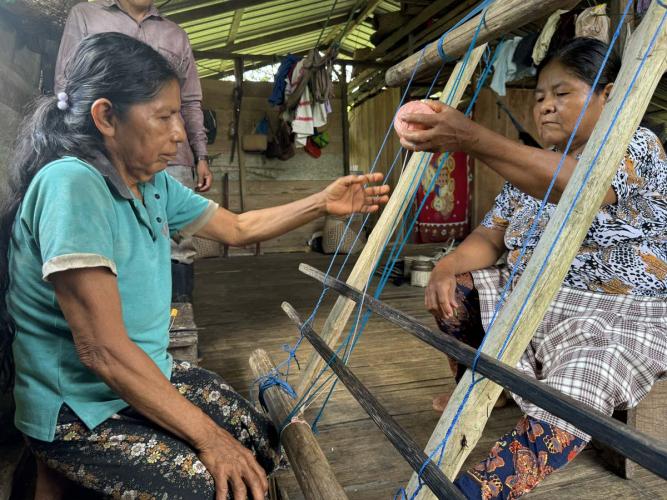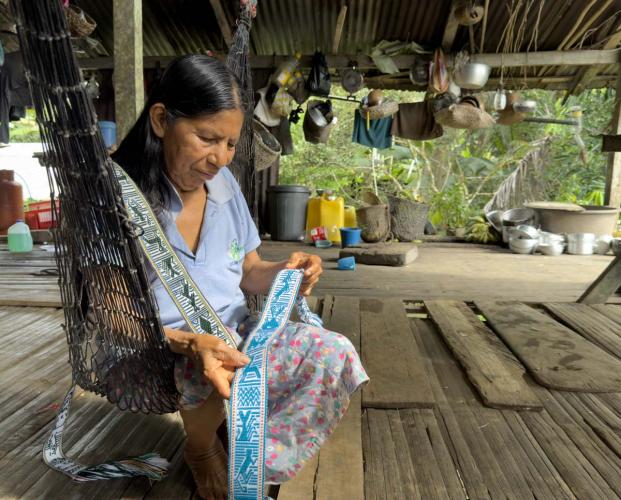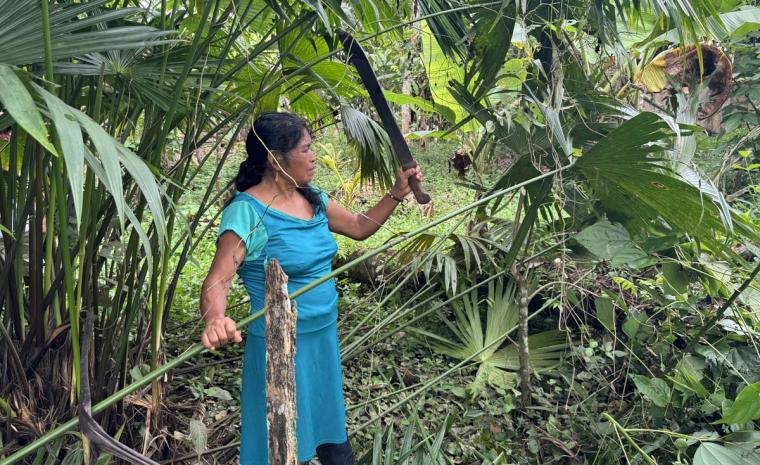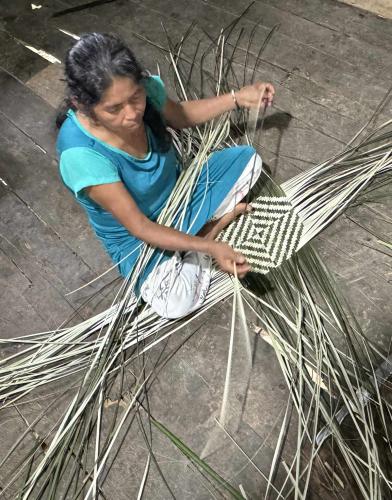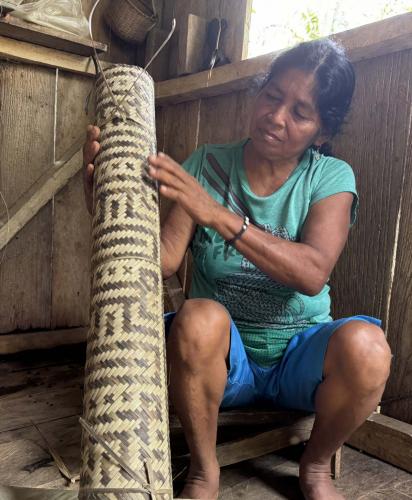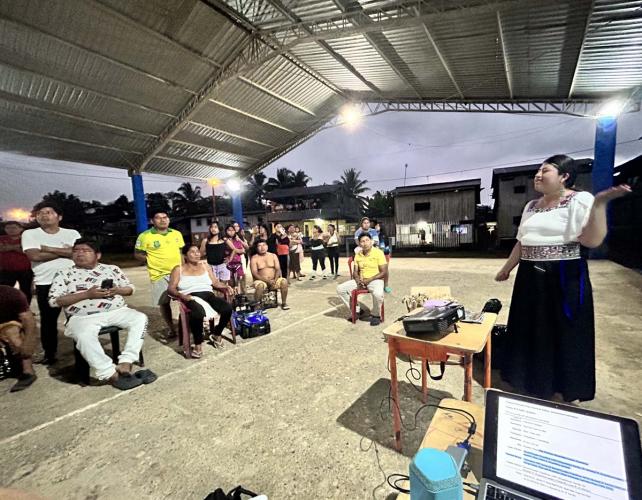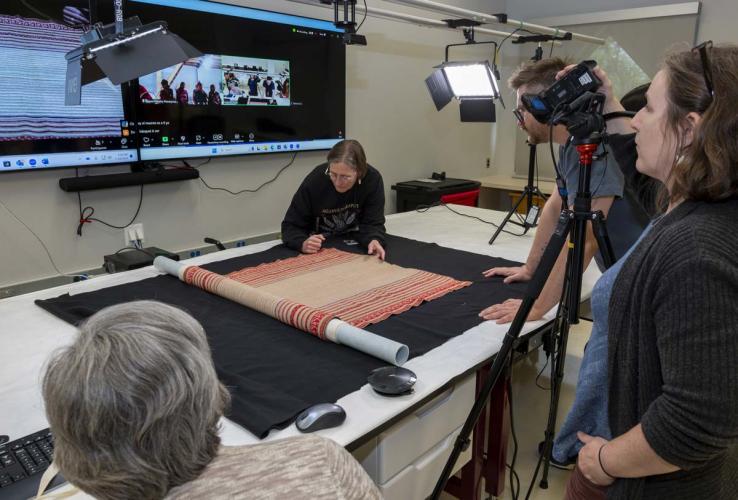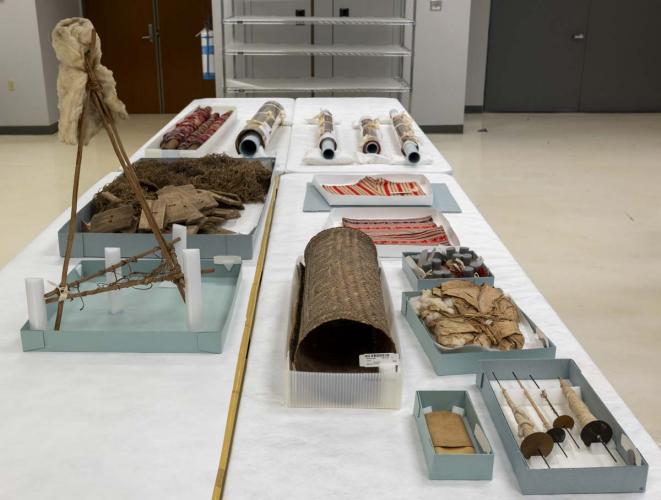After a 10-hour bus journey from Ecuador’s capital city of Quito in the Andes Mountains, Sammia Quisintuña Chango packed her gear into a motorized canoe for the final 4-hour leg of her journey. She was just south of the Colombia border and eager to keep moving toward her final destination, the Chachi village of Loma Linda.
Quisintuña Chango, who is of Kichwa Chibuleo and Salasaka heritage, was at the time working for the National Museum of the American Indian remotely from Chiapas, Mexico. She had been collaborating with the collection staff at the museum’s Cultural Resources Center in Maryland while also completing her anthropology master’s degree at the Center for Research and Advanced Studies in Social Anthropology. From a long line of textile weavers herself, Quisintuña Chango proposed reaching out to weavers at Loma Linda to inform them that items of their ancestors were residing in the museum’s collection and ask if they would like to view them—virtually.
But to accomplish this feat, she had to first travel to this remote tropical rainforest community to brief them about the museum and tell them about the many items that had been separated from them for more than a century. This would involve somehow getting a thick stack of reports to the village and then enough electricity to connect its residents with the museum staff online nearly 3,000 miles away.
Quisintuña Chango was traveling to Loma Linda in late November 2022, departing by river from the town of Borbón at the junction of the Santiago and Cayapas Rivers. From this bustling port where supplies for communities are paddled, floated and motored up and down the river, she said she was glad to be on the move again as drug dealers are in the area and “like to have control of these waters.”
The rains had been plentiful during the past few weeks, so the river was full and ran swiftly, erasing fears that she and the other passengers would be forced to climb out of the boat and pull it. Quisintuña Chango sat in the canoe as they chugged two hours before she had to switch canoes and continue for another two hours. Then her work truly began.
Connecting with Remote Communities
George Heye founded the NMAI’s predecessor, the Museum of the American Indian–Heye Foundation in New York during the early 20th century. He sponsored many expeditions to fill his expansive collection of Indigenous items. During one such trip from 1908 to 1909, ethnologist Samuel Barrett collected textiles, weaving tools and other delicate materials such as cotton from Loma Linda and the surrounding Chachi communities.
The Cultural Resources Center was built in Maryland to house the nearly 1 million items and photographs as well as some 500,000 digital images and films of Indigenous communities across the Western Hemisphere in the NMAI’s collection, including these from the Chachi peoples. Opening in 1999, it was designed to provide Indigenous communities information about their cultural items in the collection and welcome the members of these communities who are able to visit. In addition to seeing parts of the collection in the rows of climate-controlled and regularly cleaned shelving, visitors may request to take their peoples’ belongings to a dedicated viewing area to spend time alone with them and conduct related ceremonies.
The items in the collection are considered living and are treated respectfully according to each culture’s practices. For example, some items must only be viewed by women, others men, and still others by those who have a specific status in a community. By visiting their cultural belongings, people can infuse them with energy that they have not experienced for decades. From the Mapuche of Argentina and Chile to the Mi’kmaw people of Nova Scotia, these encounters between traditional communities and their items in the NMAI collection can be both initially painful and cathartic. “Some people who come in are first very upset because of what has been taken from them,” said Veronica Quiguango, the NMAI museum specialist of Kichwa heritage who managed Quisintuña Chango’s project. Yet, she said, “when they realize how we take care of the items and the way we respect their cultural belongings, then they understand and say thank you for taking such good care of what is now with us.”
While dozens of representatives and members of Indigenous communities visit the Cultural Resources Center each year, many others do not have the ability to finance such a trip. For elders, health and mobility challenges may make face-to-face connections with their cultural history not possible. Those coming from other countries may have additional hurdles of international air travel and visa restrictions. “Many communities in Central and South America don’t even know that these items exist,” said Quiguango.
During the beginning of the COVID-19 pandemic in 2020, travel froze and online video conference tools became more available. An idea at NMAI bloomed: staff could provide “virtual engagements,” during which Indigenous community members could examine their items in the collection they particularly wished to see through a live video feed. The response from communities has been great. Since 2020, the NMAI has conducted virtual consultations with dozens of Indigenous community members and representatives, and more sessions are being scheduled each year.
Threats to Chachi Culture
Despite Loma Linda’s remote location, the Chachi people are not insulated from outside pressures that can impact their cultural survival. Drug traffickers smuggle cocaine across the nearby border with Colombia. Illegal mining operators dredge nearby river beds for gold, and the dam on the river for hydroelectric power has lowered its water supply, and during droughts, cannot even supply the community with sufficient electricity. Timber companies have taken much of their forests, which they depend upon to make their mats, baskets and other traditional items.
Still, the population of the Chachi people has doubled from 5,000 in 1907 to 10,200 in 2010, and it continues to expand, with 17,300 Chachi people noted in a 2022 census and U.S. researchers suggesting it could be as many as 23,000. This population increase has stressed the local food supply, however, and much of their food must be brought into the community. “Thirty years ago, the fish in the river and the fish in the rainforest were abundant,” said Danner Añapa, former president of Loma Linda. He said that many more people were living off the same forests and rivers, and “Now in the summer, [river] shrimp and other fish are only found in the deeper pools.”
These issues add stress to those in the Loma Linda community fighting to preserve their Chachi culture from also drying up. Today, the Chachi peoples have limited time for traditional arts such as weaving, and the ceramics and metalworks of copper and gold that were widely practiced hundreds of years ago–and catapulted the Chachi culture to international fame–are rarely made now. Their main source of income is from another source. “We also have to spend a lot of time harvesting and drying cacao beans, where the money comes in quicker than with the weaving,” explained Danner Añapa. “The 30- and 40-year-olds think in a different way. They want to be professionals, to make money.”
Yet, when Danner Añapa can, he builds traditional ceremonial drums and sleeping mats called “damagua” from the native trees that surround his village. He said only three Chachi elders in Loma Linda still have the knowledge how to weave their traditional belts and sashes, or “chumbi,” which are intricately embroidered with images of local plants and animals. Once worn daily, now they are rarely seen. “We have lost the techniques to make certain items of clothing. Little by little we are losing it.”
These traditional weaving techniques are a means to cultural preservation, but the monkeys, butterflies and jaguars depicted in these weavings and the trees needed to make damagua are also at risk as loggers take their forests. “Ten years ago, to find a damagua tree, you went to the forest and in 30 minutes you could find one,” said Quisintuña Chango. “Now we had to walk for three hours just to find one of these trees.”
Learning Lessons from Ancestors
With the arrival of Quisintuña Chango, who is multilingual and also a weaver, a unique opportunity came for the NMAI to offer the Chachi weavers a way to see their ancestors’ textiles. By examining them closely and the related tools they used, the weavers could understand how they were made and such techniques could be then passed on to others in the community. The museum could also gain information about these items in its collection. “We wanted to make that connection,” said Quiguango.
However, the toll from foreigners visiting or invading Chachi territories has been so severe that any outsiders are assumed to be miners or loggers. In 1908, when Barrett arrived in Chachi communities, the inhabitants suspected that he was just feigning to be a scientist and that he actually intended to pillage their lands.
After Quisintuña Chango’s arrival in Loma Linda, she spent months talking with the village leaders and observing the elders creating textiles. She said she was awed as she followed Maria Añapa—one of the “wise women” of Loma Linda who are culture keepers—into the forest surrounding the community. Añapa expertly wielded a machete as she sliced off a thick palm frond from a tree and then delicately peeled off its different layers. She deftly tied them in a bundle, slung it atop her shoulder before heading back through the lush forest to the village.
At Añapa’s home that has sides open to the rainforest, she sat on the wooden floor. Using techniques passed generation to generation, she began weaving the different dazzling geometric patterns. She had some other frond strands that had been bleached by the sun. Together, these processes produced a mosaic of colors—shades of green, brown and white—which Añapa then weaved into different sections that would eventually become a mat roughly 4 feet long and 3 feet wide. Such a piece could take her more than a month to create.
After many discussions with the leaders of Loma Linda, Quisintuña Chango was eventually authorized to speak to a group of community members . A date was set, but floods, droughts, electrical blackouts and political turbulence delayed their meeting. Not until December 2023 was Quisintuña Chango, who had begun working for NMAI as a contractor, finally able to return to Loma Linda with her laptop and a projector to brief the community at a meeting held at an open-air field house. As elders and young alike gathered to listen, she described the extensive collection of Chachi items at the NMAI.
She returned in December 2024 to show community members two videos about the project, one made with the help of community member Christian Pillalaza and another by NMAI about the museum and its Cultural Resources Center. She also showed them photos of the Chachi items in the collection. At the gathering, she invited community members to comment on these ancestral textiles and tools. Quisintuña Chango began to click through the items, photograph by photograph. She stopped frequently for impromptu discussions and passionate questions and waited while Danner Añapa translated from their Cha’palaa language to Spanish and then to English and back again. When images flashed on the screen or as they flipped through photographs of the NMAI collection, community members moved closer. “They began to bring objects from their home,” Quisintuña Chango said. “They would say ‘we have one of those’ and run to get it.”
Of the many cultural belongings they viewed, a few in particular grabbed their attention. One was a tripod about 2 feet tall that was made of branches lashed together and crowned by a puffy ball of cotton. “What is this?” several Chachi women asked repeatedly. A member of the community answered that her grandmother had used such a tool to spin raw cotton into thread.
The museum also sent Quisintuña Chango 20 pounds of reports on the objects in the collection, from which community members chose which items they wanted to know more about. When the items they wished to see were selected so were six knowledge keepers of the community who would later participate in the virtual engagement sessions with the museum. This group of community artisans—two basket makers, two damagua makers and two chumbis makers—were the ones who would get to view the actual items prepared for them at the museum.
In July 2024, with the help of an electric generator, the group of six gathered before a computer screen to finally see the items of their ancestors. At the meeting with the NMAI staff, two translators (one who spoke Spanish and English and another who spoke Cha’palaa and Spanish) helped convey the information to the artisans. A video camera allowed the museum staff to zoom in closely on an object, revealing particular stitches or weaving techniques. Others asked the staff to rotate an object so they could see all sides of it, just as if they were there at the Cultural Resources Center themselves. They could ask the staff as many questions as they liked about the items over the course of two days of meetings.
“Without this virtual engagement, I’m not sure if we’d ever be able to connect,” said Kelly McHugh, head of conservation at the NMAI. “Our role is changing. We do not just present things to the public. We are increasingly providing access to world communities in ways we could never imagine.”
Planting Seeds of Knowledge
The ability to share cultural items decades old virtually with remote people such as the Chachi is a key tool in efforts to conserve traditional practices. As only a few Chachi elders are still practicing the art of weaving palm leaves into mats or baskets or local cotton into belts, many in the community fear that these skills will be forever lost. Without markets for the crafts or a younger generation willing and able to continue, such traditions may be swallowed up by modernity.
Danner Añapa said he fears that “in 30 years, there will be no more artwork,”citing the lack of community members who know what the traditional crafts looked like. As to bringing their ancestors’ belongings home, to preserve items that are a century old requires storage areas that moderate humidity, temperature and exposure to sunlight. The Chachi people hope someday to be able to build their own community museum to do so. Such a space would be “a living memorial for the next generation,” said Quisintuña Chango. However, for now, they are eager to continue their virtual engagements with the collection.
Many members also expressed an interest in visiting the NMAI. “I’d like to go to Washington,” Danner said. By studying the photos of his community’s items in NMAI archives and perhaps someday visiting the collection at the Cultural Resources Center, he hopes the Chachi can breathe life back into these traditional techniques and textiles.
In the meantime, the community is looking to their “wise women” and other culture keepers as well to be able to teach the younger generation. “For these practices to survive you have to look at two parameters: the family and early education,” said Danner Añapa. The elders who possess such knowledge are essential.
Quisintuña Chango is optimistic that Maria Añapa, one of the last to still actively practice these weaving techniques, can pass on her skills. Añapa embraced the idea, and the Chachi community is applying for funds to train her to become a teacher of ancestral weaving techniques. If she receives a scholarship or grant, she will tour the region, teaching the young and old alike. Judging by the enthusiasm she has seen at her presentations, Quisintuña Chango is certain that a teaching program can plant the seeds of knowledge in Chachi youth, which would enable these centuries-long traditions to continue.
